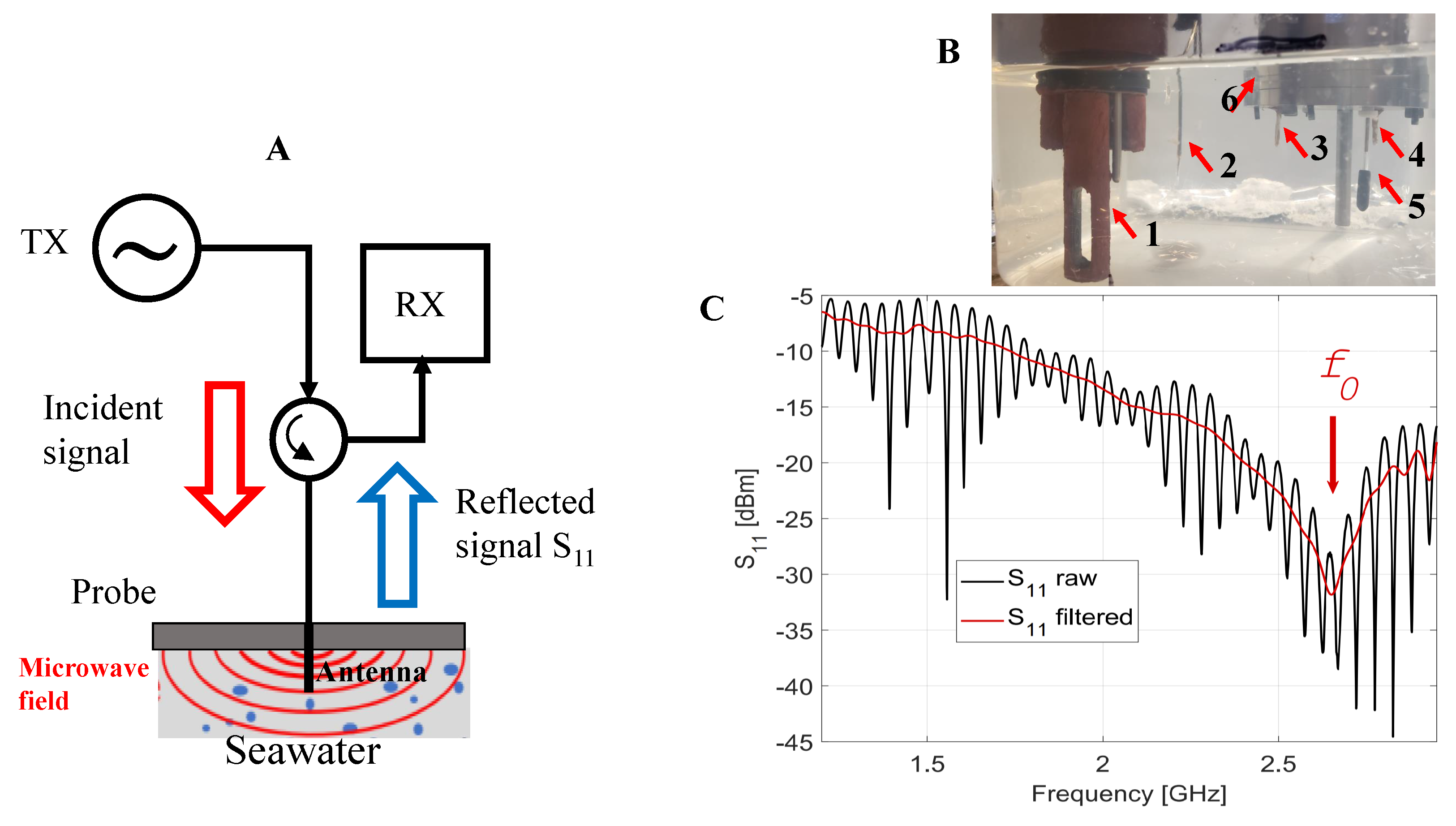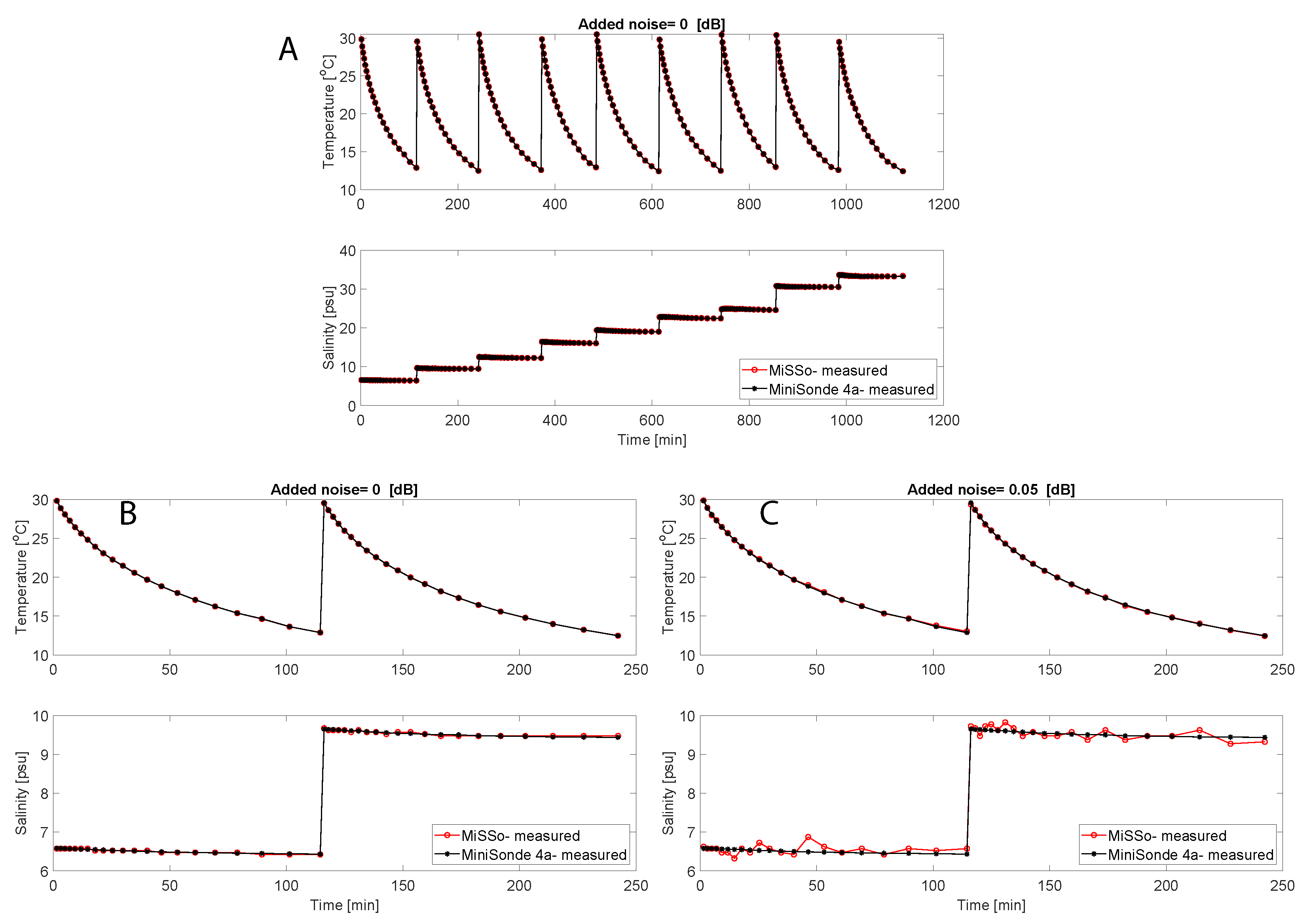A Salinity–Temperature Sensor Based on Microwave Resonance Reflection
Abstract
:1. Introduction
2. Materials and Methods
2.1. Microwave Resonance Reflectometry
2.2. MiSSo Operating Principle
2.3. Experimental Setup
- A commercial salinity and temperature sensor (MiniSonde 4a, Hydrolab) with a 1 Hz sampling rate and manufacturer-specified accuracy of 0.1 psu and 0.1 °C.
- Three FP07 (GE) fast thermistors connected to an Agilent 34970A data acquisition unit to sample water temperature with 5 Hz rate with 0.05 °C accuracy.
- The current MiSSo prototype equipped with three monopole antennas. Each antenna was approximately 1.7 cm long and was separated from the other antennas by either 5 or 2 cm distance. Each monopole antenna had resonance at approximately GHz.
- Vector network analyzer (VNA), R&S FPC 1500, (0–3 GHz range). The FPC 1500 acquired 2500 values of within a 1–3 GHz range with few Hz and <0.05 dB accuracy over a few minutes. For stability, we collected three spectra for each S and T value.
- A computer-controlled microwave switch, 0–18 GHz, (Pasternack).
- A set of 1 m long coaxial cables (Pasternack) connecting antennas to the VNA.
- A magnetic water stirrer to ensure water samples were homogeneous during measurements.
- A computer-controlled Peltier water cooler and computer-controlled water pump.
2.4. Data Management and Control
2.5. Components of the MiSSo Measured Signal
- Signal (1):
- the signal reflected off the sample;
- Signal (2):
- the standing wave signal due to the TX and RX impedance mismatch.
3. Results and Discussion
4. Conclusions
Author Contributions
Funding
Institutional Review Board Statement
Informed Consent Statement
Data Availability Statement
Conflicts of Interest
Abbreviations
| S | Salinity |
| T | Temperature |
| C | Conductivity |
| MiSSo | Microwave In situ Salinity Sensor |
| CT | Conductivity temperature |
| VNA | Vector network analyer |
| CTD | Conductivity temperature depth |
| EM | Electromagnetic |
| AUV | Autonomous underwater vehicle |
| UAV | Unmanned aerial vehicle |
| RX | Receiver |
| TX | Transmitter |
References
- Velasco, J.; Gutiérrez-Cánovas, C.; Botella-Cruz, M.; Sánchez-Fernández, D.; Arribas, P.; Carbonell, J.A.; Millán, A.; Pallarés, S. Effects of salinity changes on aquatic organisms in a multiple stressor context. Philos. Trans. R. Soc. B 2019, 374, 20180011. [Google Scholar] [CrossRef] [PubMed] [Green Version]
- Williams, P.D.; Guilyardi, E.; Madec, G.; Gualdi, S.; Scoccimarro, E. The role of mean ocean salinity in climate. Dyn. Atmos. Ocean. 2010, 49, 108–123. [Google Scholar] [CrossRef]
- Serafy, J.E.; Lindeman, K.C.; Hopkins, T.E.; Ault, J.S. Effects of freshwater canal discharge on fish assemblages in a subtropical bay: Field and laboratory observations. Mar. Ecol. Prog. Ser. 1997, 160, 161–172. [Google Scholar] [CrossRef] [Green Version]
- Boroumand, A.; Rajaee, T. Discrete entropy theory for optimal redesigning of salinity monitoring network in San Francisco bay. Water Sci. Technol. Water Supply 2017, 17, 606–612. [Google Scholar] [CrossRef]
- Chen, X.; Liu, Z.; Wang, H.; Xu, D.; Wang, L. Significant salinity increase in subsurface waters of the South China Sea during 2016–2017. Acta Oceanol. Sin. 2019, 38, 51–61. [Google Scholar] [CrossRef]
- Liu, Z.; Xu, J.; Yu, J. Real-time quality control of data from Sea-Wing underwater glider installed with Glider Payload CTD sensor. Acta Oceanol. Sin. 2020, 39, 130–140. [Google Scholar] [CrossRef]
- Johnson, G.C.; Toole, J.M.; Larson, N.G. Sensor corrections for sea-bird SBE-41CP and SBE-41 CTDs. J. Atmos. Ocean. Technol. 2007, 24, 1117–1130. [Google Scholar] [CrossRef] [Green Version]
- Garau, B.; Ruiz, S.; Zhang, W.G.; Pascual, A.; Heslop, E.; Kerfoot, J.; Tintoré, J. Thermal lag correction on Slocum CTD glider data. J. Atmos. Ocean. Technol. 2011, 28, 1065–1071. [Google Scholar] [CrossRef] [Green Version]
- Lueck, R.G.; Hertzman, O.; Osborn, T.R. The spectral response of thermistors. Deep Sea Res. 1977, 24, 951–970. [Google Scholar] [CrossRef]
- Malyuskin, O. Microplastic detection in soil and water using resonance microwave spectroscopy: A feasibility study. IEEE Sens. J. 2020, 20, 14817–14826. [Google Scholar] [CrossRef]
- Gorji, A.; Bowler, N. Static permittivity of environmentally relevant low-concentration aqueous solutions of NaCl, NaNO3, and Na2SO4. J. Chem. Phys. 2020, 153, 014503. [Google Scholar] [CrossRef] [PubMed]
- Korostynska, O.; Jansomboon, W.; Nakouti, I.; Mason, A.; Al-Shamma’a, A. Tackling water pollution: Real-time monitoring of residual antimicrobials concentration in aquaculture with microwave spectroscopy. Adv. Mater. Sci. 2018, 3, 1–6. [Google Scholar] [CrossRef] [Green Version]
- Meissner, T.; Wentz, F.J. The complex dielectric constant of pure and sea water from microwave satellite observations. IEEE Trans. Geosci. Remote Sens. 2004, 42, 1836–1849. [Google Scholar] [CrossRef] [Green Version]
- Jiménez, J. Oceanic turbulence at millimeter scales. Oceanogr. Lit. Rev. 1998, 3, 598. [Google Scholar]
- Bogucki, D.J.; Domaradzki, J.A. Temperature gradient spectra and temperature dissipation rate in a turbulent convective flow. J. Turbul. 2015, 16, 1179–1198. [Google Scholar] [CrossRef]
- Monin, A.S.; Yaglom, A.M. Statistical Fluid Mechanics: Mechanics of Turbulence; The MIT Press: Cambridge, MA, USA, 1981; p. 900. [Google Scholar]
- Venkatesan, R.; Ramesh, K.; Muthiah, M.A.; Thirumurugan, K.; Atmanand, M.A. Analysis of drift characteristic in conductivity and temperature sensors used in Moored buoy system. Ocean Eng. 2019, 171, 151–156. [Google Scholar] [CrossRef]
- Patterson, J.; Bushnell, M.; Haenggi, M. A field evaluation of the CastAway CTD at the Deepwater Horizon Oil spill site in the gulf of Mexico. In Proceedings of the OCEANS’11 MTS/IEEE KONA, Waikoloa, HI, USA, 19–22 September 2011; IEEE: Piscataway, NJ, USA, 2011; pp. 1–9. [Google Scholar]



| Added Noise: | 0.05 dB | 0.1 dB |
|---|---|---|
| Standard Deviation: | [psu/C] | [psu/C] |
| Number of Frequencies | ||
| 2 | 0.7/0.42 | 1.2/0.58 |
| 4 | 0.53/0.41 | 0.87/0.64 |
| 6 | 0.19/0.12 | 0.38/0.26 |
| 8 | 0.14/0.1 | 0.26/0.23 |
| 11 | 0.11/0.07 | 0.24/0.15 |
Publisher’s Note: MDPI stays neutral with regard to jurisdictional claims in published maps and institutional affiliations. |
© 2022 by the authors. Licensee MDPI, Basel, Switzerland. This article is an open access article distributed under the terms and conditions of the Creative Commons Attribution (CC BY) license (https://creativecommons.org/licenses/by/4.0/).
Share and Cite
Bogucki, D.J.; Snowdon, T.; Doerr, J.C.; Serafy, J.E. A Salinity–Temperature Sensor Based on Microwave Resonance Reflection. Sensors 2022, 22, 5915. https://doi.org/10.3390/s22155915
Bogucki DJ, Snowdon T, Doerr JC, Serafy JE. A Salinity–Temperature Sensor Based on Microwave Resonance Reflection. Sensors. 2022; 22(15):5915. https://doi.org/10.3390/s22155915
Chicago/Turabian StyleBogucki, Darek J., Tom Snowdon, Jennifer C. Doerr, and Joseph E. Serafy. 2022. "A Salinity–Temperature Sensor Based on Microwave Resonance Reflection" Sensors 22, no. 15: 5915. https://doi.org/10.3390/s22155915






